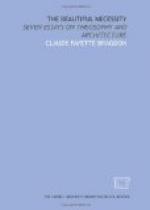[Illustration 9: CROSS SECTION OF BUTTRESS.]
The importance of the so-called “orders” lies in the fact that they are architecture epitomized as it were. A building consists of a wall upholding a roof: support and weight. The type of the first is the column, which may be conceived of as a condensed section of wall; and of the second, the lintel, which may be conceived of as a condensed section of roof. The column, being vertical, is Yo; the lintel, being horizontal, is In. To mark an entablature with horizontal lines in the form of mouldings, and the columns with vertical lines in the form of flutes, as is done in all the “classic orders,” is a gain in functional and sex expressiveness, and consequently in art (Illustration 11).
[Illustration 10: CORINTHIAN MODILLION; CLASSIC CONSOLE; IONIC CAP]
The column is again divided into the shaft, which is Yo; and the capital, which is In. The capital is itself twofold, consisting of a curved member and an angular member. These two appear in their utmost simplicity in the echinus (In) and the abacus (Yo) of a Greek Doric cap. The former was adorned with painted leaf forms, characteristically feminine, and the latter with the angular fret and meander (Illustration 12). The Ionic capital, belonging to a more feminine style, exhibits the abacus subordinated to that beautiful cushion-shaped member with its two spirally marked volutes. This, though a less rational and expressive form for its particular office than is the echinus of the Doric cap, is a far more perfect symbol of the feminine element in nature. There is an essential identity between the Ionic cap and the classic console before referred to—although superficially the two do not resemble each other—for a straight line and a double spiral are elements common to both (Illustration 10). The Corinthian capital consists of an ordered mass of delicately sculptured leaf and scroll forms sustaining an abacus which though relatively masculine is yet more curved and feminine than that of any other style. In the caulicole of a Corinthian cap In and Yo are again contrasted. In the unique and exquisite capital from the Tower of the Winds at Athens, the two are well suggested in the simple, erect, and pointed leaf forms of the upper part, contrasted with the complex, deliquescent, rounded ones from which they spring. The essential identity of principle subsisting between this cap and the Renaissance baluster by San Gallo is easily seen (Illustration 13).
[Illustration 11]
[Illustration 12]
This law of sex-expressiveness is of such universality that it can be made the basis of an analysis of the architectural ornament of any style or period. It is more than mere opposition and contrast. The egg and tongue motif, which has persisted throughout so many centuries and survived so many styles, exhibits an alternation of forms resembling phallic emblems. Yo and In are well suggested in the channeled triglyphs and the sculptured metopes of a Doric frieze, in the straight and vertical mullions and the flowing tracery of Gothic windows, in the banded torus, the bead and reel, and other familiar ornamented mouldings (Illustrations 14, 15, 16).




